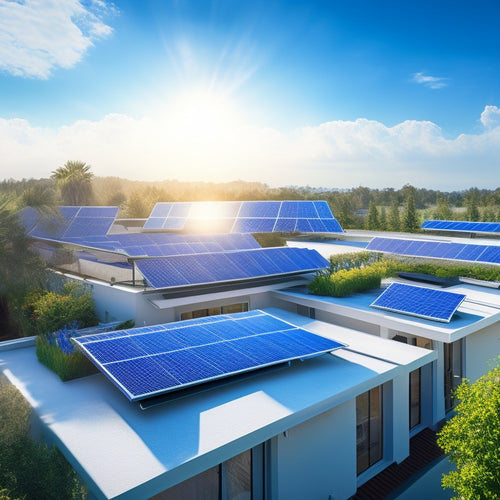
7 Energy Storage Financing Options to Explore
Share
You're exploring financing options for your energy storage project, and you've got several avenues to explore. Government incentives and grants can offer tax credits and green bonds to reduce financial burdens. Project finance and loans can provide debt financing and cash flow forecasting. Power purchase agreements, community solar programs, and corporate investments can secure revenue streams. You can also tap into crowdfunding, peer-to-peer lending, or manufacturer financing options. With these 7 financing options, you can find the right fit for your project. Now, take a closer look at each option to discover which one aligns with your project's unique needs.
Key Takeaways
• Government incentives, grants, and tax credits can reduce the financial burden of energy storage projects, making them more accessible.
• Project finance and loans can cover upfront costs, mitigate risk, and provide flexible repayment terms for energy storage projects.
• Power Purchase Agreements (PPAs) can provide a stable revenue stream for energy storage projects by selling excess energy to the grid.
• Corporate and institutional investors, such as pension funds and private equity firms, can provide financing for energy storage projects with strong ESG focus.
• Alternative financing options, including crowdfunding and peer-to-peer lending, can provide access to capital for energy storage projects with unique terms and benefits.
Government Incentives and Grants
You can leverage various government-backed incentives and grants to offset the upfront costs of energy storage systems, making them more financially viable. These incentives can greatly reduce the financial burden of investing in energy storage, making it more accessible to a wider range of individuals and organizations.
For instance, you can take advantage of Tax Credits, which provide a percentage of the total project cost as a credit against your tax liability. This can be especially beneficial for large-scale energy storage projects.
Additionally, you can explore Green Bonds, which are specifically used to finance environmentally friendly projects, including energy storage initiatives. Green Bonds offer a unique opportunity to access funding from socially responsible investors who prioritize environmental sustainability.
Project Finance and Loans
Project finance and loan options can bridge the financial gap for energy storage projects, offering a range of debt financing solutions to cover upfront costs and mitigate risk.
As you explore these options, you'll need to conduct a thorough risk assessment to identify potential pitfalls and opportunities. This involves financial modeling to forecast cash flows and revenue projections.
If you're already mid-project and facing financial strain, debt restructuring might be necessary to reorganize and refinance your debt.
Alternatively, loan syndication can provide access to multiple lenders, increasing the pool of available capital. To enhance your creditworthiness, credit enhancement mechanisms can be employed.
When negotiating loan terms, be prepared to discuss interest rates, loan tenor, and covenants that align with your project's financial goals.
Power Purchase Agreements
Power Purchase Agreements (PPAs) offer energy storage developers a lucrative opportunity to secure long-term revenue streams by selling excess energy back to the grid at a fixed rate. This financing option allows you to manage risk by locking in a predictable income stream, making it easier to secure funding from investors. Effective contract negotiation is essential to ensure a favorable PPA, as it can greatly impact your project's financial viability.
| Risk Management Strategy | Benefits | Challenges |
|---|---|---|
| Fixed Price PPA | Predictable revenue stream | Limited upside potential |
| Indexed PPA | Revenue correlated with market prices | Exposure to market volatility |
| Hybrid PPA | Balances fixed and indexed pricing | Complexity in contract negotiation |
| PPA with Storage | Optimizes energy storage benefits | Requires sophisticated forecasting |
| PPA with Renewables | Combines energy storage with renewable energy | Integration and operational complexities |
Community Solar Programs
By leveraging community solar programs, developers can tap into a new revenue stream by selling excess energy to local residents and businesses, often at a premium rate. This approach enables you to monetize the solar benefits of your energy storage project, providing a new income source.
Community solar programs promote community engagement by allowing multiple individuals or organizations to share the benefits of a single solar array. As a developer, you can structure your program to cater to local demand, ensuring that the energy generated is utilized efficiently.
Corporate and Institutional Investors
Partnering with corporate and institutional investors to tap into a vast pool of capital can be vital, particularly for renewable energy and energy storage investments. These investors often have significant funds allocated for such projects and can provide the necessary financing to support your energy storage endeavors. To attract corporate and institutional investors, understanding their investment strategies and risk appetites is crucial.
| Investor Type | Investment Strategy | ESG Focus |
|---|---|---|
| Pension Funds | Long-term, stable returns | Strong ESG focus, prioritizing impact investing |
| Private Equity Firms | High returns, portfolio diversification | Moderate ESG focus, prioritizing financial returns |
| Insurance Companies | Risk management, stable returns | Moderate ESG focus, prioritizing risk management |
When engaging with corporate and institutional investors, it's paramount to emphasize the environmental and social benefits of your energy storage project. Many investors prioritize impact investing and ESG (Environmental, Social, and Governance) considerations in their investment decisions. By understanding their risk appetite and investment strategy, you can tailor your pitch to showcase how your project aligns with their goals, increasing the likelihood of securing financing.
Crowdfunding and Peer-to-Peer Lending
Beyond institutional investors, online platforms have emerged as alternative financing options for energy storage projects, offering a range of crowdfunding and peer-to-peer lending opportunities that can be leveraged to secure funding.
As you explore these options, you'll find that crowdfunding platforms allow you to raise small amounts of money from a large number of people, often through online campaigns.
On the other hand, peer-to-peer lending platforms connect borrowers directly with investors, eliminating intermediary financial institutions. Both options can provide access to capital that mightn't be available through traditional channels.
However, it's important to be mindful of the platform risks involved, such as default rates and liquidity risks, which can impact investor returns. To mitigate these risks, it's crucial to carefully evaluate the platforms and projects you're considering, gauging their creditworthiness and potential for returns.
Manufacturer Financing Options
When exploring manufacturer financing options for your energy storage project, you'll want to explore the specific benefits of equipment leasing, in-house financing plans, and project-specific funding.
These options can provide you with more flexibility and control over your project's financials.
Equipment Leasing Options
How do equipment manufacturers' financing options, such as leases or rental agreements, facilitate access to energy storage systems for businesses and organizations? These financing options can be a game-changer for companies looking to adopt energy storage solutions without breaking the bank. With equipment leasing options, you can choose the equipment that best suits your needs and budget.
Here are some key benefits to consider:
-
Flexible lease duration: Lease terms can range from a few months to several years, giving you the flexibility to choose a lease duration that aligns with your business needs.
-
Equipment selection: You can select from a range of energy storage systems and equipment, ensuring you get the right technology for your organization.
-
Predictable expenses: Leasing options provide a fixed monthly payment, making it easier to budget and forecast expenses.
- Access to latest technology: With leasing, you can upgrade to the latest energy storage systems without a large upfront investment.
In-House Financing Plans
You can also explore in-house financing plans offered directly by energy storage system manufacturers, which can provide more tailored financial solutions and benefits compared to traditional financing options. These plans are designed to accommodate your specific energy storage needs, providing flexibility benefits that cater to your unique situation. By working directly with the manufacturer, you can take advantage of customization options that address your project's specific requirements. This personalized approach enables you to optimize your energy storage system's performance and efficiency.
In-house financing plans often provide more flexible repayment terms, allowing you to adjust your payments according to your cash flow. Additionally, manufacturers may offer bundled packages that include maintenance and support services, ensuring your system operates at peak performance.
As you explore in-house financing options, look for manufacturers that offer customized solutions, flexible payment structures, and all-encompassing support. By doing so, you'll be well on your way to securing a financing plan that aligns with your energy storage goals and budget.
Project-Specific Funding
Manufacturer financing options, such as project-specific funding, offer a tailored approach to energy storage financing. The manufacturer provides financing customized to your specific project's requirements and budget. This approach allows you to benefit from a more personalized financing solution, considering your unique project needs and constraints.
When exploring project-specific funding, you'll want to evaluate the following key factors:
-
Risk Assessment: Evaluate the potential risks associated with your project and how they may impact your financing options.
-
Cost Analysis: Conduct a thorough cost analysis to determine the total cost of ownership and identify areas for cost savings.
-
Budget Planning: Develop a detailed budget plan that accounts for all project expenses, including equipment, installation, and maintenance costs.
- ROI Evaluation and Project Valuation: Assess the potential return on investment (ROI) of your project and assess its overall value to make sure it aligns with your business goals.
Frequently Asked Questions
What Are the Typical Interest Rates for Energy Storage Project Loans?
When you're evaluating project viability, you'll find that typical interest rates for energy storage project loans range from 6-12%, depending on the lender's risk assessment, which considers factors like project duration and cash flow stability.
Can Individuals Invest in Community Solar Programs Directly?
As you begin a journey to harness the sun's power, you can directly invest in community solar programs, reaping community benefits through solar cooperatives that allow individuals to own a share of the project.
Do Manufacturer Financing Options Have Hidden Fees?
When exploring manufacturer financing options, you'll want to scrutinize the fine print for hidden fees, ensuring financing transparency. Be aware of fee structures that might inflate your costs, and don't hesitate to ask about any unclear terms.
Are Crowdfunding Platforms Secure for Energy Storage Investments?
When you invest in energy storage projects on crowdfunding platforms, you'll want to make sure they operate under a robust Regulatory Framework, prioritizing Investor Protection, so your funds are safeguarded and secure.
Can Corporate Investors Provide Project Development Funding?
"When you're digging deep for funding, can corporate investors provide project development funding? Yes, they can, but you'll need to do your due diligence on risk assessment to find the right financial partners that align with your project's vision."
Related Posts
-

What Solar Panels Work Best With EVS Online?
When shopping for solar panels online to power your electric vehicle, look for high-efficiency models that can withst...
-

What Role Do Unicycles Play in Urban Transport?
As you navigate through congested city streets, unicycles emerge as a viable solution, slashing carbon emissions by u...
-

Best Solar Panel Options for Maximum Energy Savings
You can maximize your energy savings with solar panels that boast efficiency ratings above 20%, paired with extensive...


